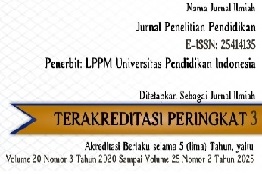Author Guidelines
- Manuscripts must be submitted through the OJS of the journal. Submission of manuscripts via email will not be considered.
- Articles must be between 5,000 to 7,000 words single-spaced (excluding Abstract and Reference sections) and in a single-column style.
- Manuscripts submitted in English with single spacing, in Word file, font size 12, Times New Roman, A4 paper with a margin of 2.54 cm.
- The manuscript does not require the author's name or institution, but please ensure that the author's metadata when submitting the manuscript in the OJS is written correctly and completely.
- Manuscript must not use any header and footer.
- If necessary, the author can use the endnotes.
- The main titles are ABSTRACT, INTRODUCTION, METHOD, FINDINGS AND DISCUSSION (separable), CONCLUSION, ACKNOWLEDGMENTS (optional), and REFERENCES. Authors are allowed to use subtitles below the main title.
- Title should be less than 8-15 words, in case of sentence, in the middle, font size 14.
- Abstract should at least contain the purpose of the paper, research methodology, and main findings/results as well as background and optional conclusions.
- The abstract must be between 200-250 words, and, under the abstract, write three to five keywords.
- The introduction must contain the background of the research, the context of the research, a review of the literature, and the purpose of the research.
- All introductions should be presented in paragraph form, avoid using pointers if possible, with a proportion of 15-20% of the overall length of the article.
- The method section consists of a description of the research design, research locations and participants or documents, data collection, and data analysis with a proportion of 10-15% of the total length of the article.
- The method section can be in the form of a unit or use subheadings.
- The findings and discussion section consists of a description of the results of data analysis to answer research questions and their meanings seen from the latest theories and references from the targeted area. The proportion of this section is 40-60% of the total length of the article.
- The conclusion section consists of a summary and restatement of the main findings.
- Quotes, citations, tables, figures and references must conform to the APA citation style.
- Every source cited in the body of the article must be included in the reference, and all sources listed in the reference must be cited in the body of the article.
- The sources cited are at least 70% from those published in the last 5 years. The sources cited are primary sources in the form of reputable journal articles (highly recommended), books, and research reports, including theses and dissertations. Quotations from journals are at least 70% of the total references cited.
- Quotations are made using brackets (last name and year of publication). When sources are quoted verbatim, page numbers are included (pp. 78 or pp. 78-89).
- All forms of communication between the author and the journal are via jpp@upi.edu. Communication to other emails will not be considered.
- Reference should be written in accordance with scientific methods (APA style).
a. Book
Hasan, S. H. (2003). Pengembangan Kurikulum. Bandung: Remaja Rosda Karya.
b. Journal
Shuman, L. S. (1987). Those Who Understand: Knowledge Growth in Teaching Educational Researcher. Educational Journal. 15/2, 4-19.
c. Bachelor and master thesis, or dissertation
Setiawati, Linda. (2012). Efektivitas Pengembangan Manajemen Pendidikan Tinggi Studi pada Perguruan Tinggi Negeri di Jawa Barat Menuju World Class University. Disertasi Doktor Universitas Pendidikan Indonesia: tidak diterbitkan.
d. Institutional publication
Departemen Pendidikan Nasional (2011). Standar Kompetensi dan Konsistensi Dasar. Jakarta: BSNI.
e. Document
Dirjen PLSP. (2004). Pedoman Penyelenggaraan Program Kecakapan Hidup (Life Skill) Pendidikan Non Formal. Jakarta: Dirjen PLSP.
f. Paper
Sudarsono. (1999). Paradigma Baru Pendidikan Indonesia dalam Abad 21. Makalah pada Seminar Pendidikan Nasional Tahun 1999, Yogyakarta.
g. Newspaper
Atmowiloto, A. (2000). Mengarang Itu Gampang. Kompas (2 Agustus 2000)
h. Internet
1) Individual work
Nurtjahjadi. (2010). Inggris Protes Ranking WCU. [Online]. Tersedia: http://edukasi.kompasiana.com/2010/10/16/inggris-protes-ranking-wcu/. [20 Oktober 2011]
2) Part of collective work
Daniel, R.T. (1995). The History of Western Music. In Britania online: Macropedia [online]. Tersedia: http://www.eb.com:180/cgi-bing:DocF=macro/5004/45/0.html [24 Maret 2000]
3) Journal article
Somantri, G. R (2005). Memahami Metode Kualitatif. Jurnal Makara. Sosial Humaniora, Vol 9 No.2. Desember 2005: 57-65. [online], Tersedia: http://jurnal.ui.ac.id/upload/artikel03_metode_penelitian_kulitatif_revisi_ybs.pdf [26 Desember 2009]
4) Magazine article
Good, C. (1991, September). Healers from the deep. American Health [CD-ROM], 60-64. Tersedia: 1994 SIRS/SIRS 1992 Life Science/Article 08A [13 Juni 1995]
5) Newspaper article
Dermawan, D. (2012, 8 Juni). Penyebab Komunikasi Terputus. Pikiran Rakyat [online], halaman 8. Tersedia: http://www.pikiran-rakyat.com [10 Juni 2001]
6) E-mail message
Setiana, S. (Sonisetiana@yahoo.com). (2013, 2 Agustus). BAB I Hasil Penelitian. E-mail Kepada Yana Mulyana (mulyanay@yahoo.com).


